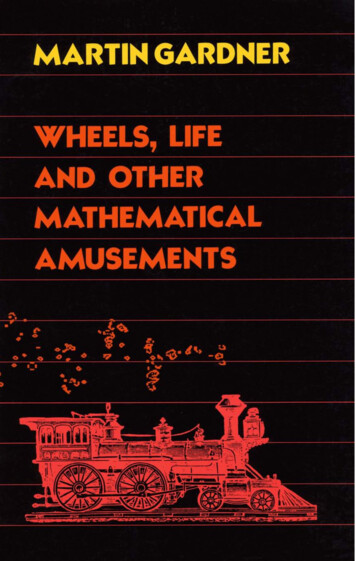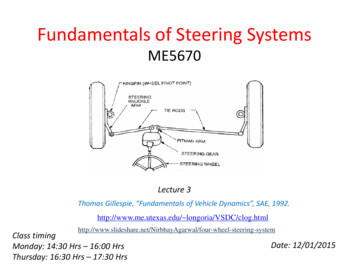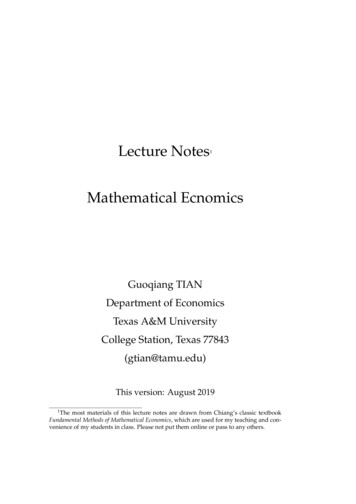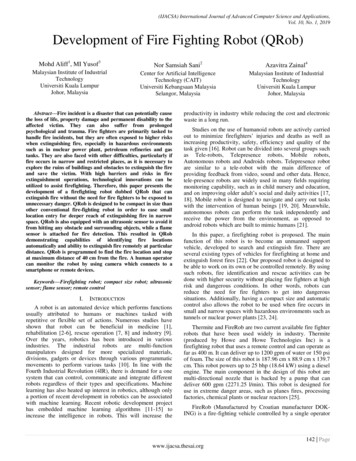
Transcription
t.*;rI-stiWHEELS,'LIFE,AND OTHERMATHEMATICALAMUSEMENTSI.tf h-.i3Tr- .".-.-.--2'iL- --*I-1 -. 10-:Q;- -90 ,*D-'9-0 , - . r76-.,\.*,'elk'a954qp46-2*GI,,
THE GAME OF LIFE, PART IMost of the work of John Horton Conway, a distinguishedmathematician at the University of Cambridge, has been inpure mathematics. For instance, in 1967 he discovered a newgroup--some call it "Conway's constellation"-that includes allbut two of the then known sporadic groups. (They are called"sporadic" because they fail to fit any classification scheme.) Itis a breakthrough that has had exciting repercussions in bothgroup theory and number theory. It ties in closely with an earlier discovery by John Leech of an extremely dense packing ofunit spheres in a space of 24 dimensions where each spheretouches 196,560 others. As Co lwayhas remarked, "There is alot of room up there."In addition to such serious work Conway also enjoys recreational mathematics. Although he is highly productive in thisfield, he seldom publishes his discoveries. One exception washis paper on "Mrs. Perkins' Quilt," a dissection problem discussed in my Mathematzcal Carnzval. Another was sprouts, a topological pencil-and-paper game invented by Conway andM. S. Paterson. It is also the topic of a chapter in the samebook.In this chapter we consider Conway's most famous brainchild, a fantastic solitaire pastime he calls "Life." Because of itsanalogies with the rise, fall and alterations of a society of livingorganisms, it belongs to a growing class of what are called "simulation games"-games that resemble real-life processes. T oplay Life without a computer you need a fairly large checkerboard and a plentiful supply of flat counters of two colors.(Small checkers or poker chips do nicely.) An Oriental "go"board can be used if you can find flat counters small enough tofit within its cells. (Go stones are awkward to use because theyare not flat.) It is possible to work with pencil and graph paper
THE GAME OF LIFE, PART Ibut it is much easier, particularly for beginners, to use countersand a board.The basic idea is to start with a simple configuration ofcounters (organisms), one to a cell, then observe how it changesas you apply Conway's "genetic laws" for births, deaths andsurvivals. Conway chose his rules carefully, after a long periodof experimentation, to meet three desiderata:(1) There should be no initial pattern for which there is asimple proof that the population can grow without limit.(2) There should be initial patterns that upparentlj do growwithout limit.(3) There should be simple initial patterns that grow andchange for a considerable period of time before coming to anend in three possible ways: Fading away completely (fromovercrowding or from becoming too sparse), settling into a stable configuration that remains unchanged thereafter, or entering an oscillating phase in which they repeat an endless cycleof two or more periods.In brief, the rules should be such as to make the behavior ofthe population both interesting and unpredictable.Conway's genetic laws are delightfully simple. First note thateach cell of the checkerboard (assumed to be an infinite plane)has eight neighboring cells, four adjacent orthogonally, fouradjacent diagonally. The rules are:(1) Survivals. Every counter with two or three neighboringcounters survives for the next generation.(2) Deaths. Each counter with four or more neighbors dies(is removed) from overpopulation. Every counter with oneneighbor or none dies from isolation.(3) Births. Each empty cell adjacent to exactly three neighbors-no more, no fewer-is a birth cell. A counter is placedon it at the next move.It is important to understand that all births and deaths occursimultaneously. Together they constitute a single generation or,as we shall usually call it, a "tick" in the complete "life history"of the initial configuration. Conway recommends the followingprocedure for making the moves:(1) Start with a pattern consisting of black counters.(2) Locate all counters that will die. Identify them by puttinga black counter on top of each.(3) Locate all vacant cells where births will occur. Put a whitecounter on each birth cell.(4) After the pattern has been checked and double-checked
CHAPTER 20to make sure no mistakes have been made, remove all the deadcounters (piles of two) and replace all newborn white organisms with black counters.You will now have the first generation in the life history ofyour initial pattern. The same procedure is repeated to produce subsequent generations. It should be clear why countersof two colors are needed. Because births and deaths occur simultaneously, newborn counters play no role in causing otherdeaths or births. It is essential, therefore, to be able to distinguish them from live counters of the previous generation whileyou check the pattern to be sure no errors have been made.Mistakes are very easy to make, particularly when first playingthe game. After playing it for a while you will gradually makefewer mistakes, but even experienced players must exercisegreat care in checking every new generation before removingthe dead counters and replacing newborn white counters withblack.You will find the population constantly undergoing unusual,sometimes beautiful and always unexpected change. In a fewcases the society eventually dies out (all counters vanishing), although this may not happen until after a great many generations. Most starting patterns either reach stable figures-Conway calls them "still 1ifes"-that cannot change or patterns thatoscillate forever. Patterns with no initial symmetry tend to become symmetrical. Once this happens the symmetry cannot belost, although it may increase in richness.Conway originally conjectured that no pattern can grow without limit. Put another way, any configuration with a finite numberof counters cannot grow beyond a finite upper limit to the numberof counters on the field. At the time this was one of the mostdifficult questions posed by the game. Conway offered a prize of 50 to the first person who could prove or disprove the conjecturebefore the end of 1970. One way to disprove it would be to discover patterns that keep adding counters to the field: A "gun" (aconfiguration that repeatedly shoots out moving objects such asthe "glider," to be explained below) or a "puffer train" (a configuration that moves but leaves behind a trail of "smoke"). Theresults of the contest for Conway's prize are discussed in the nextchapter.Let us see what happens to a variety of simple patterns.A single organism or any pair of counters, wherever placed,will obviously vanish on the first tick.A beginning pattern of three counters also dies immediatelyunless at least one counter has two neighbors. Figure 126shows the five connected triplets that do not fade on the firsttick.
THE GAME OF LIFE, PART IFigure 126The fate of five triplets in "life"(Their orientation is of course irrelevant.) The first three [a, b,c] vanish on the second tick. In connection with c it is worthnoting that a single diagonal chain of counters, however long,loses its end counters on each tick until the chain finally disappears. The speed a chess king moves in any direction iscalled by Conway (for reasons to be made clear later) the"speed of light." We say, therefore, that a diagonal chain decays at each end with the speed of light.Pattern d becomes a stable "block" (two-by-two square) onthe second tick. Pattern e is the simplest of what are called"flip-flops" (oscillating figures of period 2). It alternates between horizontal and vertical rows of three. Conway calls it a"blinker."Figure 127 shows the life histories of the five tetrominoes(four rookwise-connected counters). The square [a] is, as wehave seen, a still-life figure. Tetrominoes b and c reach a stablefigure, called a "beehive," on the second tick. Beehives are frequently produced patterns. Tetromino d becomes a beehive onthe third tick. Tetromino e is the most interesting of the lot.After nine ticks it becomes four isolated blinkers, a flip-flopcalled "traffic lights." It too is a common configuration. Figure128 shows 12 common forms of still life.The reader may enjoy experimenting with the 12 pentominoes (all possible patterns of five rookwise-connected counters)to see what happens to each. He will find that five vanish before the fifth tick, two quickly reach a stable loaf, and four in
Figure 127The life histories of the five tetrominoes
THE GAME OF LIFE, PART IFigure 128The commonest stable formsa short time become traffic lights. The only pentomino thatdoes not end quickly (by vanishing, becoming stable or oscillating) is the R pentomino ["a" in Figure 1291. Conway has trackedit for 460 ticks. By then it has thrown off a number of gliders.Conway remarks: "It has left a lot of miscellaneous junk stagnating around, and has only a few small active regions, so it isnot at all obvious that it will continue indefinitely." Its fate isrevealed in the addendum to this chapter.Figure 129The R pentomino (a) and exercises for the readerFor such long-lived populations Conway sometimes uses acomputer with a screen on which he can observe the changes.The program was written by M. J. T . Guy and S. R.Bourne. Without its help some discoveries about the gamewould have been difficult to make.As easy exercises the reader is invited to discover the fate ofthe Latin cross ["b" i n Figure 1291, the swastika [c], the letter H21 9
CHAPTER 20[dl, the beacon [el, the clock fl,the toad [g] and the pinwheel[ h ] . The last three figures were discovered by Simon Norton. Ifthe center counter of the H is moved up one cell to make anarch (Conway calls it "pi"), the change is unexpectedly drastic.The H quickly ends but pi has a long history. Not until after173 ticks has it settled down to five blinkers, six blocks and twoponds. Conway also has tracked the life histories of all the hexominoes, and all but seven of the heptominoes. Some hexominoes enter the history of the R pentomino; for example, thepentomino becomes a hexomino on its first tick.One of the most remarkable of Conway's discoveries is thefive-counter glider shown in Figure 130. After two ticks it hasshifted slightly and been reflected in a diagonal line. Geometers call this a "glide reflection"; hence the figure's name. Aftertwo more ticks the glider has righted itself and moved one celldiagonally down and to the right from its initial position. Wementioned earlier that the speed of a chess king is called thespeed of light. Conway chose the phrase because it is the highest speed at which any kind of movement can occur on theboard. No pattern can replicate itself rapidly enough to moveat such speed. Conway has proved that the maximum speeddiagonally is a fourth the speed of light. Since the glider replicates itself in the same orientation after four ticks, and hastraveled one cell diagonally, one says that it glides across thefield at a fourth the speed of light.Figure 130The "glider"Movement of a finite figure horizontally or vertically intoempty space, Conway has also shown, cannot exceed half thespeed of light. Can any reader find a relatively simple figurethat travels at such a speed? Remember, the speed is obtainedby dividing the number of ticks required to replicate a figureby the number of cells it has shifted. If a figure replicates infour ticks in the same orientation after traveling two unitsquares horizontally or vertically, its speed will be half that oflight. Figures that move across the field by self-replication areextremely hard to find. Conway knows of four, including the
THE GAME OF LIFE, PART Iglider, which he calls "spaceships" (the glider is a "featherweight spaceship"; the others have more counters). I will disclose their patterns in the Answer Section.Figure 131 depicts three beautiful discoveries by Conwayand his collaborators. The stable honey farm [a in Figure 1311results after 14 ticks from a horizontal row of seven counters.Since a five-by-five block in one move produces the fourth generation of this life history, it becomes a honey farm after 11ticks. The "figure 8" [b in Figure 1311, an oscillator found byNorton, both resembles an 8 and has a period of 8. The formc, in Figure 131 called "pulsar CP 48-56-72," is an oscillatorwith a life cycle of period 3. The state shown here has 48counters, state two has 56 and state three has 72, after whichthe pulsar returns to 48 again. It is generated in 32 ticks by aheptomino consisting of a horizontal row of five counters withone counter directly below each end counter of the row.Figure 131Three remarkable patterns, one stable and two oscillatingConway has tracked the life histories of a row of n countersthrough n 20. We have already disclosed what happensthrough n 4 . Five counters result in traffic lights, six fadeaway, seven produce the honey farm, eight end with four beehives and four blocks, nine produce two sets of traffic lights,and 10 lead to the "pentadecathlon," with a life cycle of period15. Eleven counters produce two blinkers, 12 end with two beehives, 13 with two blinkers, 14 and 15 vanish, 16 give "bigtraffic lights" (eight blinkers), 17 end with four blocks, 18 and19 fade away and 20 generate two blocks.Conway also investigated rows formed by sets of n adjacentcounters separated by one empty cell. When n 5 the countersinteract and become interesting. Infinite rows with n 1 orn 2 vanish in one tick, and if n 3 they turn into blinkers. Ifn 4 the row turns into a row of beehives.221
CHAPTER 20The 5-5 row (two sets of five counters separated by a vacantcell) generates the pulsar C P 48-56-72 in 21 ticks. The 5-5-5ends in 42 ticks with four blocks and two blinkers. The 5-5-5-5ends in 95 ticks with four honey farms and four blinkers,5-5-5-5-5 terminates with a spectacular display of eight glidersand eight blinkers after 66 ticks. Then the gliders crash inpairs to become eight blocks after 86 ticks. The form 5-5-5-55-5 ends with four blinkers after 99 ticks, and 5-5-5-5-5-5-5,Conway remarks, "is marvelous to sit watching on the computer screen." This ultimate destiny is given in the addendum.ANSWERSThe Latin cross dies on the fifth tick. The swastika vanishes onthe sixth tick. The letter H also dies on the sixth tick. The nextthree figures are flip-flops: As Conway writes, "The toad pants,the clock ticks and the beacon flashes, with period 2 in everycase." The pinwheel's interior rotates 90 degrees clockwise oneach move, the rest of the pattern remaining stable. Periodicfigures of this kind, in which a fixed outer border is requiredto move the interior, Conway calls "billiard-table configurations" to distinguish them from "naturally periodic" figuressuch as the toad, clock and beacon.The three unescorted ships (in addition to the glider, or"featherweight spaceship" are shown in Figure 132. T o be precise, each becomes a spaceship in 1 tick. (The patterns in Figure 132 never recur.) All three travel horizontally to the right withhalf the speed of light. As they move they throw off sparksthat vanish immediately as the ships continue on their way. Unescorted spaceships cannot have bodies longer than six counterswithout giving birth to objects that later block theirFigure 132Lightweight (left), middleweight (center),and heavyweight (right) spaceshipsmotion. Conway has discovered, however, that longer spaceships, which he calls "overweight" ones, can be escorted by twoor more smaller ships that prevent the formation of blockingcounters. Figure 133 shows a larger spaceship that can be es-
THE GAME OF LIFE, PART IFigure 133Overweight spaceship with two escortscorted by two smaller ships. Except for this same ship, lengthened by two units, longer ships require a flotilla of more thantwo companions. A spaceship with a body of 100 counters,Conway finds, can be escorted safely by a flotilla of 33 smallerships.ADDENDUMMy 1970 column on Conway's "Life" met with such an instantenthusiastic response among computer hackers around theworld that their mania for exploring "Life" forms was estimated to have cost the nation millions of dollars in illicit computer time. One computer expert, whom I shall leave nameless, installed a secret switch under his desk. If one of hisbosses entered the room he would press the button and switchhis computer screen from its "Life" program to one of thecompany's projects. The next two chapters will go into moredetails about the game. Here I shall comment only on some ofthe immediate responses to two questions left open in the firstcolumn.The troublesome R pentomino becomes a 2-tick oscillatorafter 1,103 ticks. Six gliders have been produced and are traveling outward. T h e debris left at the center [see Figure 1341consists of four blinkers, one ship, one boat, one loaf, four beehives, and eight blocks. This was first established at Case Western Reserve University by Gary Filipski and Brad Morgan, andlater confirmed by scores of "Life" hackers here and abroad.The fate of the 5-5-5-5-5-5-5 was first independently foundby Robert T. Wainwright and a group of hackers at Honeywell's Computer Control Division, later by many others. Thepattern stabilizes as a 2-tick oscillator after 323 ticks with fourtraffic lights, eight blinkers, eight loaves, eight beehives, and223
Figure 134R pentomino's original (black) and final (open dots) state.(Six gliders are out of sight.)
THE GAME OF LIFE, PART Ifour blocks. Figure 135 reproduces a printout of the finalsteady state. Because symmetry cannot be lost in the history ofany life form, the vertical and horizontal axes of the originalsymmetry are preserved in the final state. The maximum population (492 bits) is reached in generation 283, and the finalpopulation is 192.Figure 135Initial pattern and final state of the 5-5-5-5-5-5-5 row
THE G A M E O F LIFE, PART IICellular automata theory began in the mid-fifties when Johnvon Neumann set himself the task of proving that self-replicating machines were possible. Such a machine, given proper instructions, would build an exact duplicate of itself. Each of thetwo machines would then build another, the four would become eight, and so on. (This proliferation of self-replicatingautomata is the basis of Lord Dunsany's amusing 1951 novelThe Last Revolution.) Von Neumann first proved his case with"kinematic" models of a machine that could roam through awarehouse of parts, select needed components and put together a copy of itself. Later, adopting an inspired suggestionby his friend Stanislaw M. Ulam, he showed the possibility ofsuch machines in a more elegant and abstract way.Von Neumann's new proof used what is now called a "uniform cellular space" equivalent to an infinite checkerboard.Each cell can have any finite number of "states," including a"quiescent" (or empty) state, and a finite set of "neighbor" cellsthat can influence its state. The pattern of states changes in discrete time steps according to a set of "transition rules" that apply simultaneously to every cell. The cells symbolize the basicparts of a finite-state automaton and a configuration of livecells is an idealized model of such a machine. Conway's gameof "Life" is based on just such a space. His neighborhood consists of the eight cells surrounding a cell; each cell has twostates (empty or filled), and his transition rules are the birth,death and survival rules I explained in the previous chapter.Von Neumann, applying transition rules to a space in whicheach cell has 29 states and four orthogonally adjacent neighbors, proved the existence of a configuration of about 200,000cells that would self-reproduce.
THE GAME OF LIFE, PART IIThe reason for such an enormous configuration is that, forvon Neumann's proof to apply to actual automata, it was necessary that his cellular space be capable of simulating a Turingmachine: an idealized automaton, named for its inventor, theBritish mathematician A. M. Turing, capable of performingany desired calculation. By embedding this universal computerin his configuration, von Neumann was able to produce a universal constructor. Because it could in principle construct anydesired configuration by stretching "arms" into an empty region of the cellular space, it would self-replicate when given ablueprint of itself. Since von Xeumann's death in 1957 his existence proof (the actual configuration is too vast to constructand manipulate) has been greatly simplified. The latest andbest reduction, by Edwin Roger Banks, a mechanical engineering graduate student at the Massachusetts Institute of Technology, does the job with cells of only four states.Self-replication in a trivial sense-without using configurations that contain Turing machines-is easy to achieve. A delightfully simple example, discovered by Edward Fredkin ofM.I.T. about 1960, uses two-state cells, the von Neumannneighborhood of four orthogonally adjacent cells and the following parity rule: Each cell with an even number of liveneighbors (0, 2, 4) at time t becomes or remains empty at timet 1, and each cell with an odd number of neighbors (1, 3) attime t becomes or remains live at time t 1. It is not hard toshow that after 2" ticks (n varying with different patterns) anyinitial pattern of live cells will reproduce itself four timesabove, below, left and right of an empty space that it formerlyoccupied. The four replicas will be displaced 2" cells from thevanished original. The new pattern will, of course, replicateagain after another 2" steps, so that the duplicates keep quadrupling in the endless series 1, 4, 16, 64, . . . . Figure 136 showstwo quadruplings of a right tromino. Terry Winograd, in a1967 term paper written when he was an M.I.T. student, generalized Fredkin's rule to other neighborhoods, any number ofdimensions and cells with any prime number of states.Ulam investigated a variety of cellular automata games, experimenting with different neighborhoods, numbers of statesand transition rules. In a 1967 paper "On Recursively DefinedGeometrical Objects and Patterns of Growth," written withRobert G. Schrandt, Ulam described a number of differentgames. Figure 137 shows generation 45 of a history that beganwith one counter on the central cell. As in Conway's game, thecells are two-state, but the neighborhood is that of von Neumann (four adjacent orthogonal cells). Births occur on cells
CHAPTER 21Figure 136The replication of a trorninothat have one and only one neighbor, and all live cells of generation n vanish when generation n 2 is born. In other words,only the last two generations survive at any step. In Figure 137the 444 new births are shown as black cells. The 404 white cellsof the preceding generation wi!l all disappear on the next tick.Note the characteristic subpattern, which Ulam calls a "dogbone." Ulam experimented with games in which two configurations were allowed to grow until they collided. In the ensuing
THE GAME OF LIFE, PART IIF gure137aa47.Irb9Pd5U U im0dpo"Ood,ooboil""ub,#"q {PdIb cl, "oo ouOnobdubGeneration 45 In a cellular game dev sedbyStan slawM. Ulam"battle" one side would sometimes wipe out the other; sometimes both arniies would be annihilated. Ula nalso exploredgames on three-dimensional cubical tessellations. His major papers on cellular automata are in E u a y on Cellular Automata, edited by Arthur W. Burks.Similar ganies can he devised for triangular and hexagonaltessellations but, although they look different, they are not essentially so. All can be translated into equivalent games on asquare tessellation by a suitable definition of "neighborhood."A neighborhood need not be made up of touching cells. Inchess, for instance, a knight's neighborhood consists of thesquares to which it can leap and squares on which there arepieces that can attack it. As Burks has pointed out, games suchas chess, checkers and go can be regarded as cellular automatagames in which there are complicated neighborhoods and tran-
CHAPTER 21sition rules and in which players choose among alternative nextstates in an attempt to be first to reach a certain final state thatwins.Among the notable contributions of Edward F. Moore to cellular automata theory the best-known is a technique for proving the existence of what John W. Tukey named "Garden ofEden" patterns. These are configurations that cannot arise ina game because no preceding generation can form them. Theyappear only if given in the initial (zero) generation. Becausesuch a configuration has no predecessor, it cannot be selfreproducing. I shall not describe Moore's ingenious techniquebecause he explained it informally in an article in ScientificAmerican (see "Mathematics in the Biological Sciences," by Edward F. Moore; September, 1964) and more formally in a paper that is included in Burks's anthology.Alvy Ray Smith 111, a cellular automata expert at Kew YorkUniversity's School of Engineering and Science, found a simpleapplication of Moore's technique to Conway's game. Considertwo five-by-five squares, one with all cells empty, the other withone counter in the center. Because, in one tick, the central ninecells of both squares are certain to become identical (in thiscase all cells empty) they are said to be "mutually erasable." Itfollows from Moore's theorem that a Garden of Eden configuration must exist in Conway's game. Unfortunately the proofdoes not tell how to find such a pattern and so far none isknown. It may be simple or it may be enormously complex.Using one of Moore's formulas, Smith has been able to calculate that such a pattern exists within a square of 10 billion cellson a side, which does not help much in finding one.Smith has been working on cellular automata that simulatepattern-recognition machines. Although this is now only oftheoretical interest, the time may come when robots will need"retinas" for recognizing patterns. T h e speeds of scanning devices are slow compared with the speeds obtainable by the"parallel computation" of animal retinas, which simultaneouslytransmit thousands of messages to the brain. Parallel computation is the only way new computers can increase significantlyin speed because without it they are limited by the speed oflight through miniaturized circuitry. T h e cover of the February, 1971, issue of Scientific Arnerican [reproduced in Figure1381 shows a simple procedure, devised by Smith, by which afinite one-dimensional cellular space employs parallel computation for recognizing palindromic symmetry. Each cell hasmany possible states, the number depending on the number ofdifferent symbols in the palindrome, and a cell's neighborhoodis the two cells on each side.
THE GAME OF LIFE, PART I1Figure 138Cellular automatonSmith symbolizes the palindrome TOO HOT TO HOOT withfour states of cells in the top row. T, 0 and H are representedby blue, red and yellow respectively, and black marks the palindrome's two ends. Here we have indicated the colors by different shadings. The white cells in the other rows are in thequiescent state. The horizontal rows below the top row are successive generations of the top configuration when certain transition rules are followed in discrete time steps. In other words,the picture is a space-time diagram of a single row, each successive row indicating the next generation.In the first transition each shade travels one cell to the leftand one cell to the right, except for the end shadings, whichare blocked by black; black moves inward at each step. Eachcell on which two shadings land acquires a new state, symbolized by a cell divided into four triangles. The left triangle hasthe shading that was previously on the left, the right trianglehas the shading previously on the right. T h e result of this first
CHAPTER 21move is shown in the second row. When an adjacent pair ofcells forms a tilted square in the center that is a solid shading,it indicates a "collision" of like shadings and is symbolized byblack dots in the two white triangles of the left cell. Dots remain in that cell for all subsequent generations unless a collision of unlike shadings occurs to the immediate right of thedotted cell, in which case the dots are erased. When collisionsof unlike shadings occur, the left cell of the pair remains undotted for all subsequent generations even though like shadings may later collide on its right.At each move the shadings continue to travel one cell left orright (the direction in which the shaded triangles point) and allrules apply. If the palindrome has n letters, with n even as inthis example (the scheme is modified slightly if n is odd), it iseasy to see that after nl2 moves only two adjacent nonquiescentcells remain. If the left cell of this pair is dotted, the automatonhas recognized the initial row as being palindromic. Down thediagram's center you see the colliding pairs of like shadings inthe same order as they appear on the palindrome from thecenter to each end. As soon as recognition occurs the left cellof the last pair is erased and the right cell is altered to an "accept" state, here symbolized by nested squares. An undottedleft cell would signal a nonpalindrome, in which case the leftcell would become blank and the right cell would go into a "reject" state.A Turing machine, which computes serially, requires in general n2 steps to recognize a palindrome of length 7%. Althoughrecognition occurs here at step nl2, the accept state is shownmoving in subsequent generations to the right to symbolite thecell-by-cell transmission of the acceptance to an output boundary of the cellular space. Of course it is easy to construct moreefficient palindrome-recognizing devices with actual electronichardware, but the point here is to do it with a highly abstract,one-dimensional cellular space in which information can passonly from a cell to adjacent cells and not even the center of theinitial series of symbols is known at the outset. As Smith puts itanthropomorphically, after the first step each of
Figure 127 shows the life histories of the five tetrominoes (four rookwise-connected counters). The square [a] is, as we have seen, a still-life figure. Tetrominoes b and c reach a stable figure, called a "beehive," on the second tick. Beehives are fre- quently produced patterns. Tetromino d becomes a beehive on the third tick.











